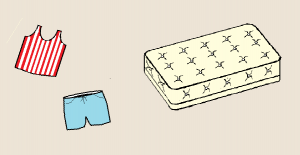
John is looking for a lightweight jacket, one to keep him dry and cool on a rainy summer day. He finds a Windbreaker online “with performance fabrics.”
“Huh?” he thinks, “What’s that?”
Mary needs another jogging outfit. She wants to stay cool and dry, not soggy and itchy as in the old running clothes. Aha! Here on Amazon is a top-and-shorts combo made of “high level performance fabric.”
“Okay,” she mutters, “They’re throwing all these new-fangled terms at me.”
Jack & Jill need a new mattress. Walking through Mattresses Galore, they press down on one mattress after another. Jill lies on one and pops off quickly. Jack tries another one, sighs, and says to Jill, “Let’s take a closer look at this one.”
Jill lifts the tag and reads the specifications. After listing the interior components, such as titanium coils and memory foam, it describes the cover: “Stretch-knit performance fabric to conform to you, keep you dry, and balance temperature.”
“Jack, have you ever heard of performance fabric?”
“I’ve heard the term, but have no idea what it is.”
So, what is performance fabric? How is it made? And what is it used for?
_______________________________________
So, what are performance fabrics?
Wikipedia says, “Performance fabrics are fabrics engineered for a wide variety of uses where the performance of the fabric is the major parameter.”
Textile Glossary defines performance fabrics as “Fabrics made for a variety of end-use applications, which provide functional qualities, such as moisture management, UV protection, anti-microbial, thermo-regulation, and wind/water resistance.”
According to one writer, some natural fiber products may be considered “performance fabrics.” For instance, Merino wool is excellent at wicking moisture. But most performance fabrics were designed to perform in certain ways.
Performance fabrics may be ordinary cloth which is coated or otherwise treated to achieve specified properties. The fibers themselves may be engineered to act in certain ways. For instance, synthetic fibers, such as polyester, nylon, or rayon, can be extruded with a cross section forming channels for moisture, or formed with protruding hairs for trapping air.
One old performance fabric was oilcloth. It was cotton duck canvas coated on one side with boiled linseed oil (the same oil used in oil based paints) and metal salts. The result was a flexible waterproof fabric which was lighter and less expensive than leather. In the middle of the 20th Century, vinyl replaced linseed oil in oilcloth. I remember wooden kitchen tables covered with vinyl oilcloth.
Later, silicone was sprayed or otherwise applied to tents, canvas tarps, and outerwear to make it water repellent. A lightweight rain shell is washable, but has to be retreated after washing. A common treatment is Scotchguard by 3M.
A well-known current performance fabric is Gore-Tex. Invented in 1969, it is a membrane fabric coated with Teflon. This membrane is the middle of a layered fabric. It will repel water, but still be breathable, allowing water vapor to escape. In other words, keeping the rain out doesn’t turn your suit into a sweat-box.
Performance fabrics do more than manage moisture. Some manage temperatures directly. One means of doing this is to make the fabric more heat conductive. With common fibers providing the required strength and flexibility, heat conducting materials are spun into the threads, or woven or knit into the fabric. These may be metallic strands. But one choice is carbon fibers (also known as fibrous graphite).
Moisture wicking fabrics provide cooling by the evaporation of the moisture drawn out to the surface. Since a user perspires more when hot, this is when evaporation is greatest, cooling when most needed. But what if it is too cool? Can the fabric switch from cooling to heating.?
Some performance fabrics are actually engineered to keep temperatures within a specified range, not just evaporate drawn out moisture. How do they do this? The fabric is infused with Phase Change Materials (PCMs). PCMs change their physical state (solid-liquid-gas), absorbing heat to cool the fabric, and releasing heat to warm it up.
PCM-infused fabrics are a type of smart (interactive) fabrics. They react to specific changes in the environment.
Two major categories of performance fabrics are value added fabrics and engineered fabrics. Value added fabrics are regular fabric which has been coated, infused or otherwise treated to add the desired properties. Engineered fabrics are formed from fibers which already have the characteristics of the finished material.
Just a few major producers of performance fabrics are DuPont, Milliken and Invista. Milliken has four types of performance fabrics. Invista makes Outlast, and DuPont produces Sorona. Besides these, there are many other perfomance fabric manufacturers.
Now we have enough performance fabrics on the market that, as the saying goes, “You need a score card to know the players.” Performance fabrics are quickly becoming so prevalent that soon they may be taken for granted.
Wikipedia: https://en.wikipedia.org/wiki/Performance_fabrics
Textile Glossary: http://www.textileglossary.com/terms/performance-fabrics.html
Fabric Link: http://www.fabriclink.com/dictionaries/performanceglossary.cfm#P
Apparel Search:
http://www.apparelsearch.com/terms/p/performance_fabrics_term.html
Atsko:
http://www.atsko.com/proper-care-for-performance-fabrics/
Atayne:
https://www.atayne.com/learn/news/science-made-simple/performance-fabrics/
Milliken:
http://www.milliken.com/en-us/pands/Pages/performance-workwear.aspx
Invista:
http://www.invista.com/en/fibers-fabrics/index.html
This entry was posted on Saturday, January 30th, 2016 at 10:31 PM and is filed under buying a mattress, cover, fabrics, materials, mattress covers, PCMs, Phase Change Materials, upholstery, wool . You can follow any responses to this entry through the RSS 2.0 feed. You can leave a response, or trackback from your own site.

Get New Post Notification via Email:
